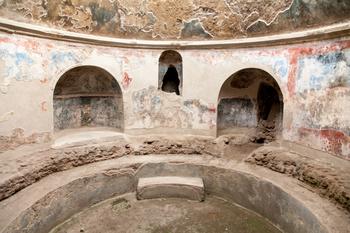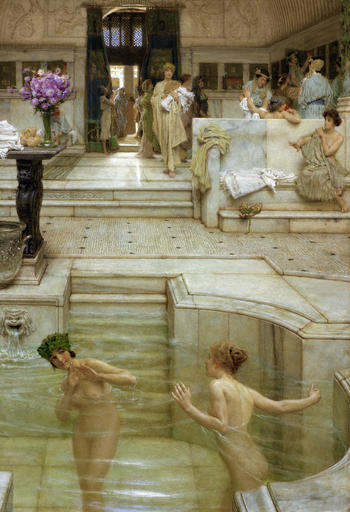Joys of Bathing in Antiquity
Monika Trümper, a professor of classical archaeology, studies the history of baths in antiquity – and the physical culture that existed at the time.
Oct 05, 2016
It is still easy to imagine the splendor of the Roman baths.
Image Credit: Jürgen Reichmann
In 1909 Sir Lawrence Alma-Tadema, inspired by photographs of excavations of the buried city of Pompeii, painted this scene of the Stabian spas.
Image Credit: akg-images
“If you have not bathed in the thermal baths of Etruscus, you will die unwashed,” the Roman poet Martial enthused at the end of the first century A.D., describing a friend’s bath. The water there was so clear, he said, that one might even think the marble pools were empty.
Archaeologist Monika Trümper, a professor of classical archaeology at Freie Universität Berlin, suspects that the water there, like at most baths, must have been more of a cloudy soup transported to Rome in water pipes. Still, she says, this early poem in praise of the baths testifies to the importance of bathing in antiquity, one of her areas of emphasis in her research activities.
Socializing and intricate rituals of body care in a public bath or a “bathing suite” in a private residence were part of what Romans of both sexes viewed as a good life, she explains. At the time when Martial was writing, thermal baths had already been perfected into something akin to today’s spas, offering increasingly refined “programs.” They were also a social space where people went with friends, and where members of different social classes – and probably, on occasion, men and women alike – met. Even the emperor himself visited the public baths from time to time.
The culture of bathing originated not in Rome, but in ancient Greece. Homer’s Odyssey contains a passage describing the water’s beneficial effect on Odysseus, who has “not enjoyed any care for a long time.” The view of the hot bath “warmed his heart.”
However, public baths do not appear in the archaeological record until Athens in the second half of the fifth century. They include the public baths known as the balaneion at the temple of Zeus in Olympia, which featured a room with hip baths placed next to each other. “Individual forms of bathing were still predominant here,” Trümper says. Bathers poured warm water over themselves, so the practice was a bit more like showering than bathing. They then scooped up the water that collected in the bottom of the tub to reuse it.
Visiting Thermal Baths Was Part of the Good Life for the Romans
One of the first new developments was the installation of underfloor heating using a “hypocaust” system. It helped ensure that not only the warm water itself, but the entire room helped foster a sense of well-being. The design of the baths also grew increasingly lavish, featuring arches, pillars, and stucco – and this despite the fact that heating reasons alone would have dictated that the rooms tend to be windowless and dark right up into the age of the Roman Empire, Trümper explains. The resulting spaces invited people to linger and relax with others. Another contributing factor was a warm plunge pool that was heated from below and featured curved backrests, she says. Sweat baths were also added. “This was a place where people could spend time together,” the professor explains.
One particular example is found in the ancient city of Morgantina, Sicily – where Trümper and her team returned to dig this past summer. Their excavations on the “South Baths,” which were used between about 250 and 211 B.C., showed that the facility had a “state-of-the-art bathing program” at the time. There were individual cleansing options as well as relaxing forms of collective bathing. The complex encompassed 14 rooms, a water distribution system that may have already been complex, and an extraordinary find: a large boiler, preserved in its entirety. How the system worked – and above all, where the water for the large plunge pools came from – is something the archaeologists do not know yet.
As part of a research project for the Topoi Cluster of Excellence – a research alliance in ancient studies between Freie Universität and Humboldt-Universität zu Berlin – Trümper has excavated two Roman baths in Pompeii in recent years. She says the sites clearly show how heating and water supply technology were perfected over the subsequent centuries.
The Republican Baths were built in the second century B.C., even before Pompeii became a Roman colony, and finally ceased operation toward the end of the first century B.C., when a private house was built over them. A discontinued bath is a very special find for archaeologists. “The baths were obviously no longer up to date,” Trümper says. “It wasn’t worthwhile for the owner, probably a private individual, to keep operating them, since other baths had more attractions.” Around the start of the first century A.D., Pompeii had two to three large public bath complexes for a population estimated at around 10,000 people. There were also smaller baths and baths at sports facilities and in private homes. Another bath was still under construction when the city was destroyed, in 79 A.D.
New Forms of Bathing Possible through Technical Innovations
At the Stabian Baths – named for the Via Stabiana, where they were located – the preserved rooms with their barrel vaults, paintings, and stucco still allow visitors today to form an impression of what it would have been like to visit the Roman baths before the devastating eruption of nearby Mount Vesuvius. At these thermal baths, which were built at the end of the second century B.C., the floors were not the only things that were heated.
The heating even extended to the walls, right up to the vaulted ceiling, in rooms with different temperatures – the tepidarium and the caldarium, the central room in any bath complex, featuring a warm plunge pool. In the early part of the first century A.D., a connection to the urban water supply made it possible to build completely new bathing facilities.
These included, first, a frigidarium, a room with cold pools, and then a natatio, a cold-water swimming pool at the edge of the palaestra, or sports grounds. Excavations in the spring of 2016 showed that these pipes must have still been in working order even after the earthquake of 62 A.D., which preceded the eruption, since the baths were modernized and expanded once again afterward.
There were separate areas for men and women at both the Republican Baths and the Stabian Baths. The women’s areas were smaller, with fewer amenities, and they were less accessible. In the Greek baths, the lavishly designed rooms with relaxing luxury forms of bathing may even have been reserved exclusively for men, Trümper believes. Men and women may also have bathed at different times. In antiquity, the basic practice was to bathe naked, although there could have been lightweight forms of bathing apparel. The Roman attitude toward nakedness was no longer quite as relaxed as the Greeks’, however.
Even though people encountered one another clad only in wooden bath slippers, possibly with a cloth wrapped around their hips, that doesn’t necessarily mean they met as equals, the archaeologist explains. “How healthy and well-fed a body was said a lot about that person’s status, just as his hairstyle did.” Jewelry was probably worn at the baths as well, to judge from the fact that pieces of jewelry have been frequently found in drainage pipes.
But how clean and hygienic were baths in an era when there was no soap? “You definitely can’t apply present-day standards of hygiene,” Trümper says. Still, she assumes that the baths were kept relatively clean, since guests were probably required to clean themselves before they entered the pool or sweat bath.
“Even back in the Greek baths, many small pools were found. People could use these pools to pre-clean themselves before entering a collective tub.” Oil also played an important role in the cleansing ritual; it was used both before bathing, to remove dirt, and afterward. Still, the baths must have been “hotspots for transmission of infectious diseases,” Trümper says, especially because physicians often prescribed a visit to the baths as a treatment for their patients. Still, she explains, “Taking time for this kind of body care almost every day shows just how important this subject was in ancient times.”
Further Information
Prof. Dr. Monika Trümper, Institute of Classical Archaeology, Freie Universität Berlin, Tel.: +49 30 838 6031, Email: monika.truemper@fu-berlin.de


